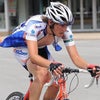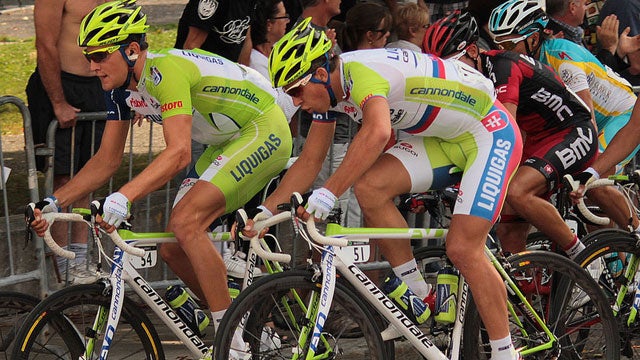Within the first meters of the Tour de France’s 4th stage, a 25-Kilometer Team Time Trial, American , of Cannondale Pro Cycling Team, is struggling to stick with his squad. The other eight riders are curled into aerodynamic missiles on their time trial bikes, freight-training along at nearly 40 miles-per-hour, but King is stuck sitting up on his road bike due to separated shoulder (it was too painful to ride his aggressively aerodynamic TT bike). After just 150 meters, King loses the wheel ahead of him and is left to finish the course alone.
Some 32 minutes later—the exact time remains a mystery—he crosses the line and heads back to the hotel with his continued participation of the race in limbo. Race rules state that he’ll be disqualified from the Tour if his time is 25 percent slower than the winning team’s.
On the results sheet, the officials simply write a cryptic HD, for outside of the permitted time, indicating that King has missed the cutoff. A little later, race officials clarify his time as 32:32.60—seven seconds outside the limit. King’s own bike computer registered a time right on the line. “By my count, I’m at 32:24. I’m honestly not sure where 32:32 is coming from,” King . He included an image from his cycling computer showing his pace and time.
Many others were confused and angered as well. Soon, Twitter was spilling over with protests under the hashtag #LetTedRide. Prominent coach Allen Lim, that “King’s 7-second elimination from Tour sends wrong message,” while race favorite Chris Froome’s girlfriend “7 seconds? Seriously?!? @letour @iamtedking #LetTedRide.”
Officially, the Tour relies on two electronic timing systems. (King’s personal data, apparently, is irrelevant). Riders start each stage with an electronic transponder that sends a seven-digit code to race officials after crossing the line. But the Tour has another more precise method of timing used for photo finishes that corresponds slices of finish line footage with the race clock.
King may have a transponder rigged on the road bike by his team mechanic (details are still unconfirmed), but regardless officials did not use any transponder data for his time. That leaves only the photo-based measurement system to rely on in this case. But in a video interview with Bicycling Magazine, the Tour jury president refused to explain exactly how King’s time was taken. And a spate of reports from the race, including one from �������⳦�����Բ�’s Whit Yost clearly show that King’s time was , not with a camera.
Tour officials refuse to question their handwork or admit that a process that’s supposedly digital and precise, i.e. irrefutably objective, has come down to a subjective decision. Addressing a timing discrepancy—in the world’s largest timed event—is something they apparently cannot do.
After the time trial, riders continued to come out in King’s support, asking officials to invoke a mercy clause. As recently as 2011, officials have allowed riders, including Mark Cavendish, finishing upwards of 35 minutes back of the winner to continue racing.
Instead of giving the fans and riders what they wanted, officials chose to take a position hostile to the peloton with real repercussions for King.
“I’m in a tough place now,” King said by phone from France. “I’m so emotionally shredded. All I wanted to do was race the Tour. I wasn’t asking for mercy from the ASO [the Tour’s management company], but for some empathy and understanding.”
Four days into the race, it’s clear neither empathy nor understanding are high on race officials’ agenda. In addition to booting King, reigning World Time Trial Champion Tony Martin for riding a bike with the rainbow stripes of the world champion. Martin, officials explained, had no right to be riding them: he’s the individual world time trial champion, but he was competing in a team time trial, they said. The logistics of having two separate race-day time trial bikes (in addition to training time trial bikes) is something officials, apparently, don’t appreciate.
Which is exactly the problem. In reading the rulebook as a textualist reads the U.S. Constitution, officials have absconded from their most fundamental duties: Keeping riders safe and protecting the heritage of the sport. As for King, lacking photo-finish proof of his time, it remains a stubborn refusal among race officials to do all they can to allow riders to ride.
Pointless suffering is, ultimately, what underlines much of cycling. King’s futile but stubborn perseverance in the face of pain makes the perfect centennial homage to the Tour. It’s a shame the officials couldn’t recognize that.


